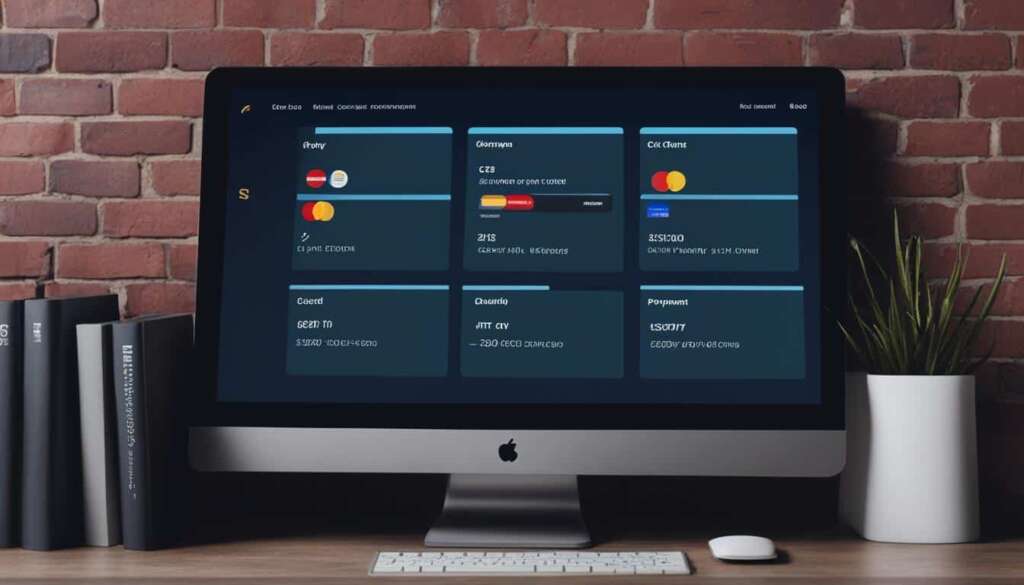Table of Contents
In today’s digital landscape, e-commerce payment systems play a critical role in ensuring smooth transactions and seamless customer experiences. To maximize conversions and drive success, businesses must focus on optimizing their e-commerce payment systems. With the right strategies in place, businesses can enhance the checkout process, reduce declined transactions, protect against fraud, consolidate apps, communicate effectively with payment processors, and understand payment processing costs. By implementing these optimization strategies, businesses can unlock the true potential of their e-commerce payment systems and achieve success in the competitive online marketplace.
Focus on the Customer Experience
One important aspect of optimising e-commerce payment systems is to focus on creating a frictionless checkout experience for customers. By prioritising customer convenience and ease of use, businesses can increase conversions and encourage customer retention.
Offer a Frictionless Checkout Experience
Creating a frictionless checkout experience is essential for providing a seamless transaction process. By implementing a one-page checkout process, businesses can eliminate unnecessary steps and reduce the likelihood of cart abandonment. This streamlined approach minimises friction and allows customers to complete their purchase efficiently.
Provide Alternative Payment Methods
Offering alternative payment methods is another way to enhance the customer experience. By providing options such as “buy now, pay later” services, ACH (Automated Clearing House) payments, or cryptocurrency, businesses can cater to the diverse preferences of their customers. This flexibility in payment options reduces barriers to purchase and increases the likelihood of successful transactions.
Take Inspiration from Competitors
Looking to competitors can provide valuable insights into improving the customer experience. By studying how other businesses in the same industry handle their checkout process, businesses can gather ideas and identify areas for enhancement. This benchmarking exercise helps in identifying best practices and staying ahead of the competition in terms of customer convenience and satisfaction.
| Benefits of a Frictionless Checkout Experience | Alternative Payment Methods | Inspiration from Competitors |
|---|---|---|
| Increases conversion rates | Appeals to a wider range of customers | Identifies opportunities for improvement |
| Reduces cart abandonment | Simplifies the checkout process | Enhances the overall customer experience |
| Improves customer satisfaction | Provides flexibility and convenience | Encourages innovation and adaptation |
In order to optimise e-commerce payment systems, businesses must focus on providing a frictionless checkout experience for their customers. By offering a seamless one-page checkout process, providing alternative payment methods, and taking inspiration from competitors, businesses can improve customer satisfaction, increase conversions, and promote customer retention.
Know Why Transactions Get Declined
Understanding why transactions get declined is crucial for optimising e-commerce payment systems. Many business owners lack this knowledge, which makes it difficult to explain to customers and find appropriate solutions. By analysing declined transaction data, businesses can identify common issues such as insufficient funds or auto-decline settings in the address verification process. Addressing these issues can lead to higher conversion rates and increased revenue.
| Common Reasons for Declined Transactions | Solutions |
|---|---|
| Insufficient Funds | Ensure customers have adequate funds, offer alternative payment methods |
| Expired Card | Prompt customers to update their payment information, provide clear instructions |
| Auto-Decline by Address Verification | Modify address verification settings, implement manual review process |
| Card Issuer Restrictions | Inform customers to contact their card issuer, provide alternative payment options |
“By analysing declined transaction data, businesses can identify common issues such as insufficient funds or auto-decline settings in the address verification process.”
Addressing these issues requires a proactive approach. For example, insufficient funds can be resolved by ensuring customers have adequate funds in their accounts or by offering alternative payment methods. To counter auto-decline settings, businesses can modify address verification settings and implement a manual review process to minimize false positives. By understanding the reasons behind declined transactions and implementing appropriate solutions, businesses can optimize their e-commerce payment systems for enhanced conversion rates and increased revenue.

Protect Against Fraud
Protecting against fraud is essential for e-commerce businesses. The cost of fraud has increased significantly, and it can lead to expensive chargebacks and potential termination by payment processors. While many businesses rely on address verification for fraud filtering, this method has limitations. Implementing more advanced fraud detection and chargeback protection tools can help businesses capture more sales and mitigate the risks associated with fraudulent transactions.
Advanced fraud detection systems leverage sophisticated algorithms and machine learning techniques to identify and flag suspicious transactions in real-time. These systems analyze various data points, such as transaction patterns, device information, and behavioral analytics, to identify any signs of fraudulent activity. By detecting fraud early on, businesses can prevent financial losses and maintain the trust of their customers.
Chargeback protection is another crucial aspect of fraud prevention. Chargebacks occur when customers dispute a transaction and request a refund from their credit card issuer. Chargebacks can result in financial losses and damage a business’s reputation. To protect against chargebacks, businesses can employ chargeback management tools or partner with payment processors that offer chargeback protection services. These services help businesses navigate the chargeback process, provide evidence to support their case, and increase the likelihood of a favorable outcome.
In addition, businesses should stay updated on emerging fraud trends and continuously adapt their fraud prevention strategies. Fraudsters are constantly evolving their tactics, making it imperative for businesses to stay one step ahead. Regularly reviewing and optimizing fraud prevention measures can help businesses detect and prevent new forms of fraud.
Implementing comprehensive fraud prevention measures, including advanced fraud detection systems and chargeback protection, can protect businesses from financial losses and reputational damage. By investing in robust fraud prevention strategies, businesses can create a secure environment for both themselves and their customers, ensuring a seamless and trustworthy e-commerce experience.
Benefits of Advanced Fraud Detection and Chargeback Protection:
- Minimizes financial losses due to fraudulent transactions
- Enhances customer trust and loyalty
- Reduces the likelihood of chargebacks and associated costs
- Identifies and blocks suspicious transactions in real-time
- Provides valuable insights and data for fraud analysis
Best Practices for Fraud Prevention:
- Implement multi-factor authentication for additional security
- Regularly review and update fraud prevention policies
- Train employees on fraud detection and prevention
- Monitor transactions and customer behavior for anomalies
- Stay informed about emerging fraud trends and tactics
| Key Components of Fraud Prevention | Importance |
|---|---|
| Advanced fraud detection systems | Essential for real-time identification of fraudulent transactions |
| Chargeback protection | Reduces financial losses and reputational damage caused by chargebacks |
| Regular monitoring and analysis | Ensures ongoing optimization of fraud prevention strategies |
| Employee training | Empowers employees to detect and report potential fraud |
Consolidate Third-Party Apps
Consolidating third-party apps is a strategic approach that can significantly optimize e-commerce payment systems. Many businesses frequently utilize multiple apps for payment processing, subscriptions, and upsells, resulting in higher fees and increased expenses. However, by consolidating these apps and streamlining the tech stack, businesses can achieve valuable benefits such as improved website performance, cost savings, and enhanced data privacy and security.
Consolidating payment processors and apps simplifies the payment workflow, making it more efficient and reducing the potential for errors or delays. It allows businesses to streamline their operations by eliminating the need for complex integrations and reducing the number of vendors they interact with. This consolidation brings several advantages that positively impact the bottom line.
One of the key benefits of consolidating third-party apps is cost savings. By reducing the number of apps and payment processors used, businesses can eliminate redundant fees, integration costs, and maintenance expenses. Additionally, consolidating payments often leads to negotiating better rates with payment processors, resulting in long-term cost reductions. These cost savings can significantly contribute to a business’s profitability.
Another critical advantage is enhanced data privacy and security. When businesses use multiple apps and payment processors, their customer data is spread across different systems, increasing the risk of data breaches or unauthorized access. By consolidating apps, businesses can centralize their data, reducing the number of companies with access and, therefore, enhancing data privacy and security. This not only protects sensitive customer information but also helps businesses comply with data privacy regulations.
To further illustrate the benefits of consolidating third-party apps, consider the following table:
| Benefits of Consolidating Third-Party Apps |
|---|
| Cost Savings |
| Improved Website Performance |
| Reduced Complexity and Frustration |
| Enhanced Data Privacy and Security |
Consolidating third-party apps presents businesses with a valuable opportunity to optimize their e-commerce payment systems, achieve cost savings, and enhance data privacy and security. By streamlining the tech stack and centralizing payment processing, businesses can simplify operations, reduce expenses, and mitigate potential risks. It is a strategic approach that should be considered by any e-commerce business looking to achieve long-term success.

Keep Your Processor Informed
Maintaining open communication with your payment processor is essential for optimising e-commerce payment systems. By keeping your processor informed of any significant changes in your business, you can ensure compliance with processor guidelines, effectively manage risks, and maintain a smooth payment processing experience.
Why Communication is Vital
Effective communication with your payment processor establishes a strong working relationship and enables seamless collaboration. By sharing relevant information, you contribute to a more efficient and secure payment processing ecosystem. Timely updates ensure that your processor can adapt to changes and provide the necessary support for your evolving business.
Compliance with Processor Guidelines
Adhering to your payment processor’s guidelines is crucial for maintaining a positive payment processing experience. These guidelines may include rules and regulations related to transaction volumes, types of products or services sold, and acceptable processing practices. Keeping your processor informed about any updates or changes in your business helps ensure ongoing compliance.
Effective Risk Management
Proactive communication with your payment processor plays a vital role in effective risk management. By sharing insights about new product launches, marketing campaigns, or sudden spikes in sales volume, you enable your processor to assess and manage potential risks more efficiently. This collaborative approach minimizes the chances of account freezes, risk assessments, or fund holding.
Effective communication with your payment processor establishes a strong working relationship and enables seamless collaboration.
| Benefits of Keeping Your Processor Informed | Actions to Take |
|---|---|
| Smooth payment processing | Notify your processor of any significant changes or updates in your business. |
| Compliance with processor guidelines | Regularly review and adhere to your processor’s guidelines and policies. |
| Effective risk management | Inform your processor about new product launches, marketing campaigns, and changes in sales volume. |
Keeping your payment processor informed builds trust, promotes a collaborative relationship, and ensures optimal performance for your e-commerce payment systems.
Understand Payment Processing Costs
Understanding payment processing costs is vital for optimising e-commerce payment systems and maximizing profits. While many business owners only consider the effective rate, there are often hidden fees and rate increases that can significantly impact the bottom line. By delving deeper into processing statements and gaining a thorough understanding of payment processing fees, businesses can make informed decisions and allocate resources effectively.
When it comes to payment processing fees, it’s important to go beyond the surface-level effective rate. This rate may seem low initially, but additional fees can quickly add up and erode profits. By carefully analyzing processing statements, businesses can identify and mitigate hidden fees that may be eating into their revenue.
One common hidden fee to watch out for is the “PCI compliance fee.” Payment Card Industry (PCI) compliance is essential for ensuring data security, but some processors may charge a separate fee for this. Understanding whether this fee is included in the effective rate or charged separately can help businesses accurately assess their payment processing costs.
Additionally, businesses should pay attention to rate increases. Some processors may offer low rates initially to attract customers and then gradually increase them over time. Regularly reviewing processing statements and staying vigilant to rate hikes can help businesses negotiate better rates or switch to a more cost-effective processor.
| Key Considerations for Understanding Payment Processing Costs |
|---|
| Look beyond the effective rate to uncover hidden fees |
| Identify separate fees for PCI compliance |
| Regularly review processing statements for rate increases |
| Consider negotiating rates or switching processors for cost savings |
Having a comprehensive understanding of payment processing costs enables businesses to make informed decisions and optimize their e-commerce payment systems. By carefully examining processing statements, businesses can identify hidden fees, negotiate better rates, and ultimately maximize their profitability.
Conclusion
Optimising e-commerce payment systems is crucial for businesses looking to succeed in the digital marketplace. By focusing on the customer experience, understanding why transactions get declined, protecting against fraud, consolidating third-party apps, keeping processors informed, and understanding payment processing costs, businesses can enhance their conversion rates, facilitate frictionless transactions, and ultimately drive success in the e-commerce space.
By prioritising the customer experience and offering a frictionless checkout process, businesses can reduce barriers to purchase and increase conversion rates. Understanding the reasons behind transaction declines, such as insufficient funds or address verification issues, allows businesses to address these issues and keep the payment process seamless for customers.
Protecting against fraud is essential for maintaining the trust of customers and avoiding costly chargebacks. By implementing advanced fraud detection measures and chargeback protection tools, businesses can minimize the risk of fraudulent transactions and ensure secure transactions for their customers.
Consolidating third-party apps not only streamlines the payment process but also saves costs and enhances data privacy. By reducing the number of apps involved in payment processing, businesses can improve website performance, reduce expenses, and enhance the security of customer data.
Keeping processors informed about significant changes in the business, such as new product lines or sales volume increases, helps maintain a smooth payment processing experience. This proactive communication prevents potential issues and ensures that the payment system is optimized for the business’s evolving needs.
Finally, understanding payment processing costs beyond the effective rate is crucial for maximizing profits. Identifying hidden fees and rate increases allows businesses to make informed decisions and allocate resources effectively, ultimately driving success and increased profitability.
By implementing these strategies and optimising e-commerce payment systems, businesses can enhance their conversion rates, facilitate frictionless transactions, and thrive in the competitive e-commerce marketplace.
FAQ
What strategies can businesses employ to optimise their e-commerce payment systems?
Businesses can focus on the customer experience, understand why transactions get declined, protect against fraud, consolidate third-party apps, keep their payment processors informed, and understand payment processing costs.
How can businesses create a frictionless checkout experience for customers?
Businesses can offer a one-page checkout process, provide alternative payment methods such as “buy now, pay later” options, ACH, or cryptocurrency, and gather ideas from competitors for improving the customer experience.
Why is it important to understand why transactions get declined in e-commerce payment systems?
Understanding why transactions get declined can help businesses identify common issues such as insufficient funds or auto-decline settings in the address verification process, leading to higher conversion rates and increased revenue.
How can businesses protect against fraud in e-commerce payment systems?
Businesses can implement advanced fraud detection and chargeback protection tools to capture more sales and mitigate the risks associated with fraudulent transactions.
How can businesses consolidate third-party apps in their e-commerce payment systems?
By consolidating payment processing, subscriptions, and upsells apps, businesses can improve website performance, save money, and enhance data privacy and security.
Why is it important to maintain open communication with the payment processor?
Maintaining open communication with the payment processor ensures smooth payment processing and avoids potential issues such as risk assessments or fund holding.
Why is it important to understand payment processing costs in e-commerce payment systems?
Understanding payment processing fees beyond the effective rate can help businesses uncover hidden fees and rate increases, allowing them to make informed decisions and allocate resources effectively.
How can optimising e-commerce payment systems enhance conversion rates and facilitate frictionless transactions?
By implementing strategies such as focusing on the customer experience, protecting against fraud, consolidating third-party apps, and understanding payment processing costs, businesses can enhance conversion rates and drive success in the digital marketplace.













